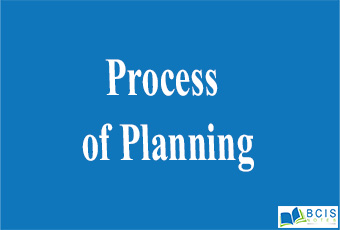
Process of Planning
The planning process is the steps a company takes to develop budgets to guide its future activities. The documents developed may include strategic plans, tactical plans, operating plans, and project plans. Determining objectives and the courses of action needed to obtain these objectives are referred to as the planning process.
The process of planning are:
- Analyze opportunities- An important part of the planning process is to be aware of the business opportunities in the firm’s external environment as well as within the firm. Once such opportunities get recognized the managers can recognize the actions that need to be taken to realize them. A realistic look must be taken at the prospect of these new opportunities and SWOT analysis should be done.
- Setting goals- This is the second and perhaps the most important step of the planning process. We establish the objectives for the whole organization and also individual departments. Organizational objectives provide a general direction, objectives of departments will be more planned and detailed.
- Determination of premises- The planning premises are also of two types – internal and external. External assumptions deal with factors such as political environment, social environment, the advancement of technology, competition, government policies, etc. Internal assumptions deal with policies, availability of resources, quality of management, etc.
- Determination of alternatives- The fourth step in planning is to identify the alternatives. Various alternatives can be identified based on the organisational objectives and planning premises. The concept of various alternatives suggests that a particular objective can be achieved through various actions.
- Evaluation of alternatives- The various alternative course of action should be analysed in the light of premises and goals. There are various techniques available to evaluate alternatives. The evaluation is to be done in light of various factors. Example, cash inflow and outflow, risks, limited resources, expected payback etc., the alternatives should give us the best chance of meeting our goals at the lowest cost and highest profit.
- Selecting a best course of action- This is the real point of decision-making. An analysis and evaluation of alternative courses will disclose that two or more .ire advisable and beneficial. The fit one is selected. The choice is obviously based on scientific analysis and mathematical equations. But a managers intuition and experience should also play a big part in this decision. Sometimes a few different aspects of different plans are combined to come up with the one ideal plan.
- Formulation of the derivative plan- In an organisation there can be various derivative plans like planning for buying equipment, buying raw materials, recruiting and training personal, developing new product etc. These derivative plans are formulated out of the basic or main plan and almost invariably required to support the basic plan.
- Implement the plan- After formulating basic and derivative plans, the sequence of activities is determined so those plans are put into action. After decisions are made and plans are set, budgets for various periods and divisions can be prepared to give plans more concrete meaning for implementation.
- Reviewing of the planning process- Planning is a continuous function and lasts till the organization is in existence. For this, it is necessary to know about the actual performance. The manager needs to take corrective action in proper time only after evaluating the actual performance.
Therefore the process of the planning process is explained above.
You may also like Concept of Strategic Planning

Leave a Reply